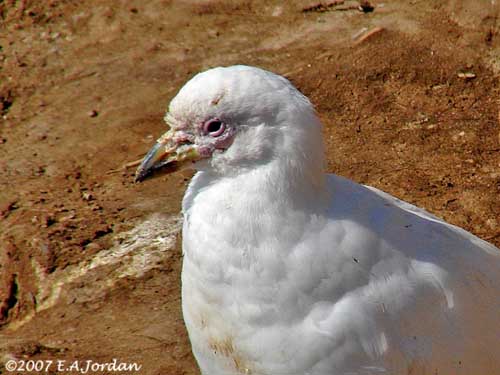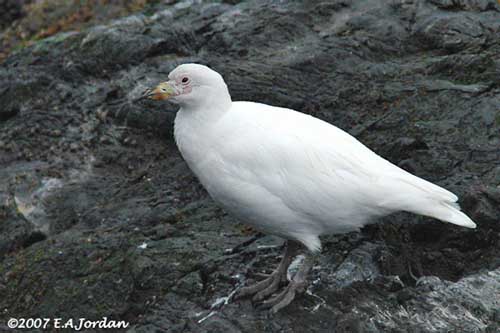
Fr: Chionis blanc
All : Weißgesicht-Scheidenschnabel
Esp : Picovaina de Malvinas
Esp (Argentine - Chili): Paloma antártica
Ital : Chione bianco
Nd: Zuidpoolkip
Sd: Större slidnäbb
Port: Pomba-antártica
Photographer:
Eduardo Andrés Jordan
MIS AVES - AVES DE ARGENTINA
Text by Nicole Bouglouan
Sources:
HANDBOOK OF THE BIRDS OF THE WORLD Vol 3 by Josep del Hoyo-Andrew Elliott-Jordi Sargatal - Lynx Edicions - ISBN : 8487334202
L’ENCYCLOPEDIE MONDIALE DES OISEAUX - Dr Christopher M. Perrins - BORDAS - ISBN: 2040185607
BirdLife International (BirdLife International)
The Cornell Lab of Ornithology – Neotropical birds
Snowy Sheathbill
Chionis alba
Charadriiforme Order – Chionidae Family
BIOMETRICS:
Length: 34-41 cm
Wingspan: 75-80 cm
Weight: 460-780 g
DESCRIPTION:
There are only two species in the family Chionidae. The Snowy Sheathbill also named Pale-faced Sheathbill, and the Black-faced Sheathbill. These birds are the only Antarctica species in having not webbed feet.
Unlike all the seabirds living in harsh environment, the sheathbills are land-based birds. They are well adapted for the rigorous climate and landscapes.
The present study is about the Snowy Sheathbill.
The adult has white plumage overall. This is a plump, pigeon-like bird.
On the head, the strong, conical bill is partially covered with a horny sheath almost until the nostrils. The bill tip is blackish, as the ridge of the upper mandible. We can also see several fleshy wattles around the base. The face skin is pale pink, as the eye-ring. The eyes are dark brown. Legs and not webbed feet are blackish and scaly.
There is not seasonal variation of plumage.

The female has similar appearance but she is smaller than male.
The downy chick is covered with dense brown down, followed later by a coat of mottled grey down.
The juvenile resembles adults with smaller sheath and facial wattles.
VOICE: SOUNDS BY XENO-CANTO
The Snowy Sheathbill utters harsh, throaty “cow, cow, cow…” and muttering.
The harsh, high-pitched calls are audible above the noise of the penguin’s colonies.
HABITAT:
The Snowy Sheathbill occurs frequently on islands and coasts, on rocky or sandy shorelines. This bird is often found in the colonies of penguins, among cormorants and albatrosses, and in seal rookeries.
RANGE:
The Snowy Sheathbill breeds on the coasts of Antarctic Peninsula and on several islands along the Scotia Arc, including South Shetland Islands, Elephant Island, South Orkney Islands and South Georgia.
Breeding is not confirmed on South Sandwich Islands.
This species leaves the breeding areas and reaches the shores of the Falkland Islands, Tierra del Fuego and South Patagonia. Some birds wander further North on both Pacific and Atlantic coasts.
The migrating birds may sometimes stop off on icebergs.
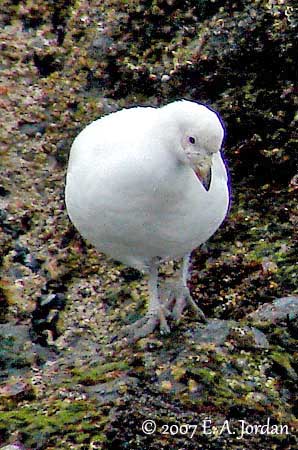
BEHAVIOUR:
The Snowy Sheathbill is omnivorous, feeding on marine preys such as krill, fish, squid and other aquatic animals often stolen from penguins. It feeds on eggs and small penguin chicks, but also from other birds.
It also takes carrion, faeces of birds and seals, algae and invertebrates, and takes advantage of seal placenta and blood, and human refuse.
This varied diet allows this bird to survive in harsh environment.
It performs successfully kleptoparasitism, and often steals food from marine birds. Both partners of a pair may harass and rob a penguin. They try to eat anything available in seal rookeries and they are very opportunistic birds.
The leafy algae are scraped off rocks at intertidal areas where it also finds invertebrates and molluscs. It may sometimes wade, but it avoids the deep water and swims only if necessary.
The Snowy Sheathbill is gregarious outside the breeding season, and often lives in groups, foraging and feeding together, and sometimes fighting too.
They spend most of their time on the ground. During the breeding season, the adults establish territories which include parts of penguin or cormorant colonies. The territory is strongly defended and the nest is placed within it.
The breeding birds roost within their cavities, whereas the others roost on rocky platforms on the shoreline.
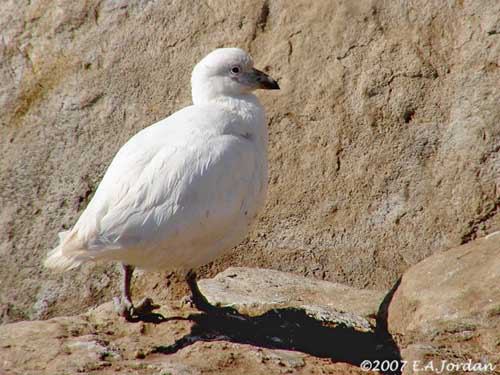
During the breeding season, the Snowy Sheathbill performs some displays. The most common is the “Bowing ceremony” during which both mates bow rapidly their heads up and down. This display is accompanied with series of staccato calls. It is used as greeting displays between mates, or in response to intruders or disturbances.
Male and female defend the territory, but usually, the male is more aggressive. The threat posture is a “forwards” display accompanied with loud calls. The intruders may be chased by running, flying, or flapping run. They are strongly territorial when breeding.
FLIGHT:
The Snowy Sheathbill’s flight is strong and direct, with continuous wingbeats and only occasional gliding. They are powerful fliers, able to migrate over hundreds of kilometres of open sea without alighting on the water.
REPRODUCTION:
The Snowy Sheathbill arrives in October-November at the breeding areas. They are monogamous and show high fidelity to mate, but also to territory and nest-site.
The nest is cup-shaped, often placed on top of debris such as tussock grass, algae, moss, feathers or old bones, and within a cavity, a rock crevice, a small cave or even in petrel burrow. When the nest is among penguins, the protection against the skuas is much better.
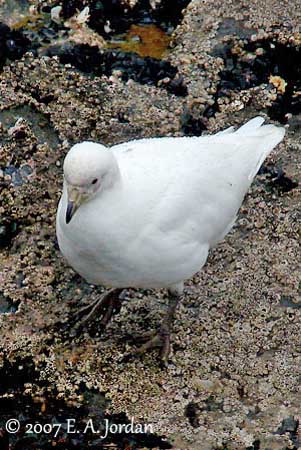
The female lays 2-3 creamy-white eggs with grey and brown markings. Both adults incubate during 28-32 days. The downy chicks are fed by both parents and fledge 50-60 days after hatching.
They forage and feed along the shoreline before to leave the breeding grounds between April and June, migrating further north. The young birds can fly at 9 weeks of age.
DIET:
The Snowy Sheathbill eats anything that is finds or steals from other seabirds. It feeds on krill, fish, squid and various marine preys. It also takes eggs and chicks from other birds’ species, carrion, algae, placenta and blood, and faeces of seals.
PROTECTION / THREATS / STATUS:
The Snowy Sheathbill is widely distributed through the breeding range. The populations appear fairly stable and healthy.
This species is not currently threatened.
